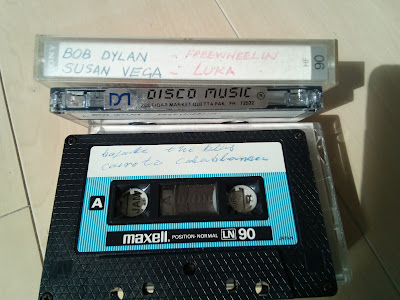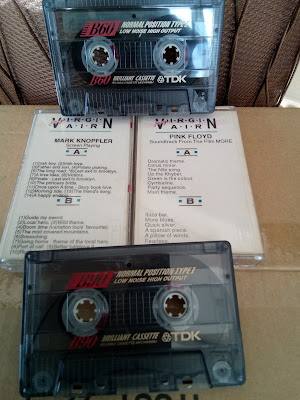The Music Centers of Quetta
Before there was MP3, there was TDK. Before there were Spotify and iTunes, there were Sangeet Palace and Odeon Music Center, Quetta.
Next to books, music occupies a huge space in my life. It also gets a significant chunk of my free time. And as in reading, so in music: I am an omnivore. I read across the genres and listen to many kinds of music. In this post, I am going to reminisce about some of the more popular and well-known music centers of Quetta, places that unfortunately no longer exist in reality but are very much present and alive in the minds and hearts of the music aficionados of the city’s old cassette tape sub-culture of the 1970s and 1980s.
I give the pride of place to Odeon Music Center. Others may disagree but as far as I can recall, this store had the largest Indian (and maybe Pakistani) music collection. Situated in the rather obscure and poorly lit Lalazar Market in the middle of Liaquat Bazaar, it used to be a double-sized corner joint with dark glass panels always adorned with huge, colorful posters that depicted famous Bollywood movies and actors: Sholay, Deewar, Dostana and Yarana with Amitabh Bachan; Anand, Amar Prem and Kati Patang with Rajesh Khanna; and, Aandhi and Mausam with Sanjev Kumar, and so on. And yes, the posters of the ubiquitous, lovely Zeenat Aman, the “sex symbol” reefer queen of the era dressed in hippy rags with her dazzling, alluring smile. Her posters were always among the big selling items of popular culture and her images could be seen everywhere, painted on the backs of auto-rickshaws and trucks and gracing the walls of college and university dorms. Even now, a predatory capitalist behemoth like Apple (the iPhone and iPad maker) cannot resist using her images for the promotion of their products. Odeon music center was equally impressive from inside, with wall-to-wall racks brimming with LPs, tapes and other music paraphernalia. It specialized in high quality stereo and echo recording and did not sell cheap pre-recorded tapes then. It had some of the finest recording equipment, big brand names like Teac, Kenwood, Onkyo, Sansui cassette decks, amplifiers and equalizers and Kenwood, JVC and Technics speakers. My father and my uncle Nasim always got their tapes from this store. All my father’s TDK and Sony Lata tapes carried the shiny silver and gold stickers reading “Odeon Music Center” on them. Recording of one’s favorite selections on a tape of one’s choice would take at least a week and sometimes even more.
 |
| Dum Maro Dum! Zeenat Aman: The Poster Queen of the 1970s |
Most of the pre-recorded tapes that I used to buy, and still have with me, were bought at Sangeet Palace on Abdus Sattar Road, Quetta. The owners of this old music store were three brothers, one of whom, Javed, was my class fellow for a while at Balochistan University. These pre-recorded tapes were the cheaper items. They were mostly manufactured in Karachi, Saddar Karachi to be precise, and sold all over the country, including at the music centers of Quetta, of which Sangeet Palace was the largest and the most famous. For a long time they were fixed at Rs. 25 per cassette. The tapes were mostly “Asahi” brand, and they were most probably Hong Kong or Thailand copies of the original Japanese Asahi. In the beginning, their recording quality was poor but over time they got better and better. Carrying miniature-poster pictures of Bollywood stars on the tape jackets and wrapped in cellophane, they weighed far less than the TDK, Sony, BASF and Scotch tapes. All cheap plastic, including the tiny screws that held the tape body together! For me, Javed was also a good source of information about music, about the ever-evolving music technology and what was new or latest in the industry then. Our Google then! Sangeet Palace did not deal in on-demand recordings. They only sold pre-recorded items but during the later years, in the early and mid 80s when VHS appeared, they expanded into the video business selling in mass quantities to smaller businesses which were mostly in the rural areas of the province. Sangeet Palace and other music stores like Bambino on Archer Road that sold the affordable pre-recorded tapes made music accessible to the masses. Not everybody could afford the high-quality Odeon Music, Disco Music and Tip Top merchandise.
 |
| Pre-recorded tapes from Sangeet Palace, Abdus Sattar Road, Quetta |
Of all the recorded English tapes that I ever bought and still have, the majority are from Disco Music Center. This music house, situated in one of the smaller markets called Zulfiqar Market in Liaquat Bazaar, was the only one in the city that specialized in high quality English music recordings. It was a tiny, tiny place, so small that three people inside it would make it look and feel over-crowded. A kiosk, a cubicle, in fact. The owner was a mustached guy--a dandy who always wore strong perfumes---related to Haji Fateh Khan of Lodi Maidan, Nichari. I think he was his son-in-law. His younger brother owns and runs some kind of an adventure or sports club in Quetta, if I am not wrong. Almost all of my Pink Floyd, Neil Young and Bob Dylan music is on Disco Music recorded TDK and Sony tapes, some on the more expensive Chrome and Metal tapes. English (middle-of-the-road-)rock and folk music---the two genres I mostly liked and often listened to in those days--- but especially the music of the 70s’ big rock bands like The Eagles, Jefferson Starship, Creedence Clearwater Revival, America, Toto, Led Zeppelin, CSNY, Cream, Journey, to name a few, required a different kind and level of recording skill on the equalizer and the amplifier. I mean a different use of settings than those required for the recording of Bollywood music. Since it was the age of vinyl, most of the famous bands and singers were originally produced on LPs from where they were transferred onto individual tapes and that required some very specialized equipment and recording studio skills. There were no programmed presets on the equalizers and amplifiers. They had to be manually manipulated and/or adjusted according to taste and demand. Tapes were recorded individually and it was a time consuming task. In Quetta of those days, Disco Music was one of the few places, if not the only place, where these tapes were made and sold. They cost a pretty penny then, more so when recorded on the high-end metal and chrome tapes for a more refined, sharper and bassy sound. My heartbeat would race, my mouth would always water, so to speak, as soon as I would step inside that rare, almost magical cubicle overflowing with the treasures of LPs and especially with the expensive equipment carrying brand names like Onkyo, Marantz and Nakamichi (amplifiers), Sansui and Technics (equalizers), Kenwood and JBL (speakers) and Teac and Denon (cassette decks). It was like stepping into a different world, a dream world.
 |
| Disco Music Tapes |
 |
| Tapes from Off-Beat Music Lahore (TDK A Series) |
 |
| The superior stuff: A TDK metal tape |
 |
| Virgin Air, Lahore cassette tapes (TDK B Series) |
TDK was the king of cassette tapes. At least it was in Quetta. In fact, quality music, good music, meant TDK. Period. It was a solid, jet black product made of opaque plastic with simple designs. The most popular was the “normal bias” “D” series tapes, especially the one-hour duration D60 with the decal printed in red, and the 90-minutes duration D90 with the decal printed in green on the black plastic. The two-hour duration D120 became available late in the 80s, or maybe in the early 90s, but was not that popular. The D series was followed by the screen-printed, transparent plastic “A” and “B” series tapes, which were not bad, but didn’t quite feel like the real thing, the legendary sturdy black D tapes. The competitors of the mighty TDK were mainly Sony, Maxell, BASF and Scotch, the last two being non-Japanese products. I liked the Sony and Maxell tapes, too. Sony Chrome II was a fine thing. Maxell black had the same heavy and sturdy look and feel as the D series. They were quality products as well. I got my BASF and Scotch tapes from my late uncle, Sikander Ali, who had brought them from Germany. They were also good products but not as popular in Quetta as the Japanese brands like TDK and Sony. Only a few stores sold them. The BASF tapes with their yellow and orange stickers on black background were very attractive. To this day, they remind me of the 70s superstars like the reggae king Bob Marley and especially Al Stewart and his catchy guitar tunes and songs. I guess it is because the first time I ever heard an Al Stewart song ---“Year of the cat” and also “On the Border”, for example--- was on a BASF tape given to me by my uncle.
 |
| The Mighty TDK D Series D60 and D90 Tapes |
 |
| BASF and Scotch tapes |




























